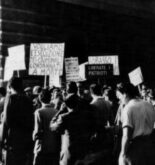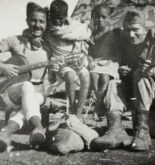Luca Campisi, L’impatto sociale. I protagonisti delle pratiche giudiziare a Vercelli fra XIV e XV secolo, Dottorato di ricerca in Storia, cultura e teorie della società e delle istituzioni (XXXIV ciclo), tutor prof.ssa Beatrice Del Bo
La presente ricerca nasce con l’obiettivo di valutare l’impatto che ebbero, sui procedimenti
penali celebrati dal tribunale podestarile di Vercelli, le risorse economico-sociali in possesso delle
parti e quali effetti potesse avere l’appartenenza a un determinato segmento sociale sulla fisionomia
e sulla qualità dei reati commessi, tanto in città quanto nelle località del contado. Questi interrogativi
hanno portato l’analisi a concentrarsi sulla documentazione giudiziaria prodotta nella città
eusebiana fra gli anni Settanta del Trecento e i Quaranta del secolo successivo, sfruttandola come
lente d’osservazione della società del tempo, e dei conflitti interni ad essa una volta portati sui
banchi dei giudici cittadini. In base all’indirizzo dato alla ricerca si è poi allargato lo spettro
d’indagine alle fonti notarili e agli atti del consiglio cittadino, con l’intento di raccogliere il maggior
numero possibile di informazioni sui soggetti coinvolti nelle diverse fasi della disputa giudiziale.
Grazie ai dati raccolti è stato così realizzato un database contenente i profili personali di circa 3000
individui, provenienti dall’ambiente cittadino e dai borghi del contado e comparsi in tribunale in
qualità sia di indagati sia di vittime.
Per poter comprendere a fondo gli aspetti sociali della giustizia pubblica, la riflessione ha
interessato, in un primo momento, il ruolo ambivalente assunto dal processo, da una parte, quale
dispositivo di legittimazione del potere, dall’altro, quale strumento a disposizione delle parti per la
gestione del conflitto. Si sono quindi analizzate le modalità attraverso cui l’estrazione sociale, i
capitali a disposizione e le reti di conoscenze personali potevano impattare sulle pratiche penali,
influenzando le capacità processuali dei soggetti coinvolti e, di conseguenza, il giudizio finale delle
magistrature cittadine. I privati avevano infatti a disposizione un ampio ventaglio di soluzioni per
tentare di ottenere giustizia, ma le risorse clientelari e finanziarie in loro possesso potevano rivelarsi
decisive per scegliere quale canale delatorio sfruttare. Successivamente all’avvio dell’inchiesta,
l’estrazione sociale degli indagati o degli attori era in grado di influenzare notevolmente la strategia
processuale da loro adottata, consentendo a essi di sfruttare le dilatazioni temporali concesse dal bando per ottenere un vantaggio nella disputa giudiziaria, rivolgendosi ad esempio a un procuratore
per la formulazione delle difese e per evitare, se possibile, di finire sotto tortura.
Dopo aver inquadrato gli schemi procedurali e la loro sensibilità alle risorse socioeconomiche
delle parti, una sezione è stata dedicata ai soggetti che si muovevano attorno al banco
di giustizia. Si sono quindi studiati i canali di reclutamento e l’estrazione sociale sia degli officiali
signorili sia di quelli di nomina locale, per poi dedicare attenzione a quelle figure che, dopo essere
state introdotte nella contesa dalle parti, intervenivano nel processo, in veste di fideiussori, per
evitare che si ingolfasse, oppure, come procuratori, per cercare consapevolmente di bloccarlo.
Infine, è stata proposta una lettura della criminalità in chiave sociale, nel tentativo di evidenziare
l’incidenza delle categorie delittuose maggiormente dibattute nei diversi contesti sociali. Si sono
quindi analizzate le direttrici delle offese, sia fisiche sia verbali, dei furti e delle azioni sovversive,
focalizzando l’analisi sui protagonisti delle azioni violente e su come l’appartenenza a diversi
segmenti sociali potesse impattare sulle forme assunte dagli assalti. L’immagine restituita dalle carte
giudiziarie e quella di una comunità viva, attraversata da continue tensioni, dove le reti di
conoscenze personali e il grado di inserimento nella comunità, nonché le risorse economiche a
disposizione, pesavano notevolmente sulla gestione della disputa davanti alle autorità cittadine e
sulle forme attraverso cui questa conflittualità poteva esprimersi.
The present research was born with the objective of evaluating the impact that the
economic and social resources of the parties had on the criminal proceedings celebrated by the
court of podestà in Vercelli, and the effects that belonging to a certain social segment could have on
the physiognomy and the quality of the crimes committed, both in the city and in the surrounding
countryside. These questions led the analysis to focus on the judicial documentation produced in
the city between the seventies of the fourteenth century and the forties of the following century,
using it as a lens for observing the society of the time, and the conflicts within it once brought to
the benches of the city judges. Based on the direction given to the research, the spectrum of
investigation was then widened to include notarial sources and the acts of the city council, with the
intention of gathering as much information as possible on the subjects involved in the different
phases of the judicial dispute. Thanks to the data collected, a database was created containing the
personal profiles of about 3000 individuals, from the city and the villages of the countryside, who
appeared in court as both suspects and victims.
In order to fully understand the social aspects of public justice, the reflection has, at first,
focused on the ambivalent role assumed by the process, on the one hand as a device of legitimation
of power, and on the other as a tool available to the parties for the management of conflict. The
ways in which social background, available capital and networks of personal acquaintances could
impact on criminal practices, influencing the trial skills of the subjects involved and, consequently,
the final judgment of the city magistrates, have than been analyzed. Private individuals, in fact, had
at their disposal a wide range of solutions to try to obtain justice, but the clientelistic and financial
resources in their possession could prove decisive in choosing which delatory channel to exploit.
After the start of the investigation, the social extraction of the suspects or actors was able to
considerably influence the procedural strategy adopted by them, allowing them to exploit the time
extensions granted by the notice to obtain an advantage in the judicial dispute; for instance, turning
to a prosecutor for the formulation of the defense and to avoid, if possible, ending up under torture.
After framing the procedural schemes and their sensitivity to the socio-economic resources
of the parties, a section was devoted to the subjects that moved around the court bench. The
recruitment channels and the social extraction of both the seigniorial officials and those of local
appointment have therefore been studied, and attention has been devoted to those figures who,
after being introduced into the dispute by the parties, intervened in the process, as guarantors, to
prevent it from clogging, or, as attorneys, to consciously try to block it. Finally, a reading of
delinquency from a social point of view has been proposed to highlight the incidence of the most
debated criminal categories in the different social contexts. The guidelines of both physical and
verbal offenses, thefts and subversive actions, have therefore been analyzed, focusing on the
protagonists of violent actions and on how the belonging to different social segments could impact
the forms assumed by the assaults. The image returned by the judicial papers is that of a lively
community, crossed by continuous tensions, where the networks of personal acquaintances and
the degree of insertion in the community, as well as the economic resources available, weighed
considerably on the management of the dispute before the city authorities and on the forms
through which this conflict could be expressed.



